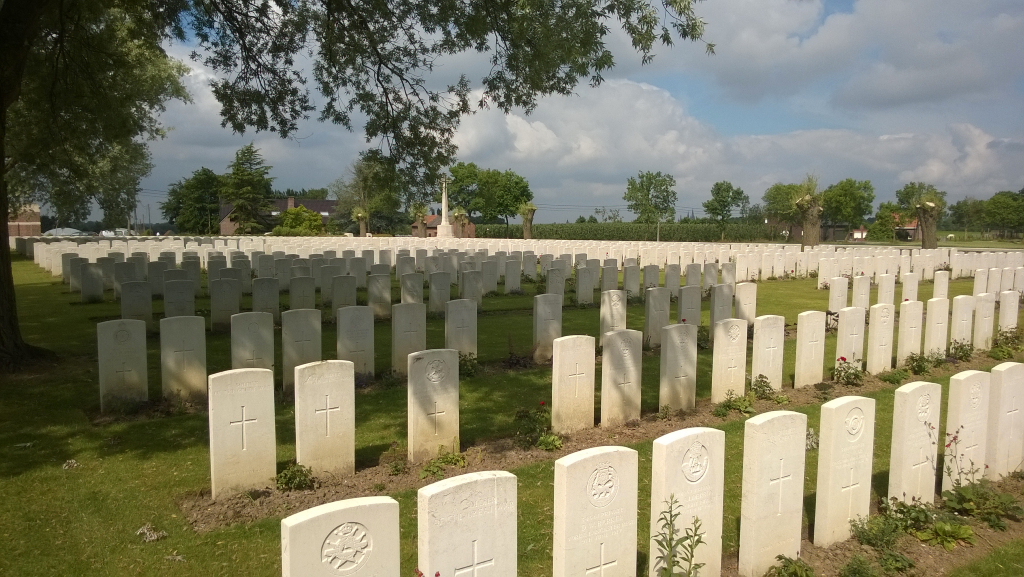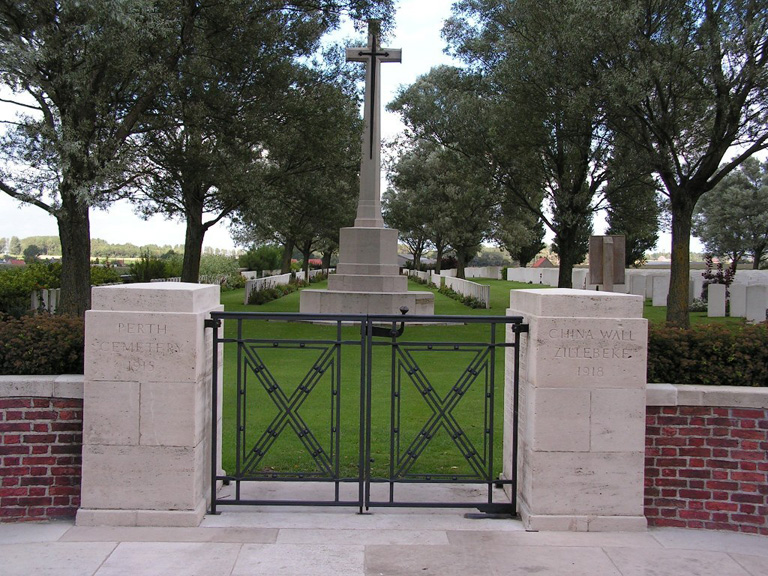Perth Cemetery (China Wall)
- Country Belgium
- Total identified casualties 1429 Find these casualties
- Region West-Vlaanderen
- Identified casualties from First World War
- GPS Coordinates Latitude: 50.84213, Longitude: 2.92075
Location information
Perth Cemetery (China Wall) is located 3 Kms east of Ieper town centre, on the Maaldestedestraat, a road leading from the Meenseweg (N8), connecting Ieper to Menen.
From Ieper town centre the Meenseweg is located via Torhoutstraat and right onto Basculestraat. Basculestraat ends at a main cross roads, directly over which begins the Meenseweg.
1.7 Kms along the Meenseweg at a major roundabout lies the right hand turning onto the Maaldestedestraat. The cemetery itself is located 1 Km along the Maaldestedestraat on the left hand side of the road.
Visiting information
Wheelchair access to the cemetery is possible via main entrance. For further information regarding wheelchair access, please contact our Enquiries Section on telephone number 01628 507200.
History information
The cemetery was begun by French troops in November 1914 (the French graves were removed after the Armistice) and adopted by the 2nd Scottish Rifles in June 1917. It was called Perth (as the predecessors of the 2nd Scottish Rifles were raised in Perth), China Wall (from the communication trench known as the Great Wall of China), or Halfway House Cemetery. The cemetery was used for front line burials until October 1917 when it occupied about half of the present Plot I and contained 130 graves. It was not used again until after the Armistice, when graves were brought in from the battlefields around Ypres and from the following smaller cemeteries:-
BECELAERE GERMAN CEMETERY No.1 (246th RESERVE INFANTRY REGIMENT), close to Becelaere Church, contained about 500 German and two British burials.
BELGIAN CHATEAU CEMETERY, VLAMERTINGHE, in the grounds of a chateau 2 Kms South-West of Ypres. It contained the graves of 12 soldiers from the United Kingdom, 11 from Canada, and one French soldier, dating from 1914 to 1917.
BROODSEINDE GERMAN CEMETERIES, ZONNEBEKE. These contained the graves of 27 British soldiers, who fell mainly in 1914. Broodseinde gave its name to the Battle of the 4th October 1917; and the Memorial of the 7th Division, which fought here in 1914 and 1917, is a little South of the hamlet on the road to Becelaere.
DURHAM CEMETERY, ZILLEBEKE, at the North end of the village, was used from December 1915 to March 1916. It contained the graves of 52 soldiers from the United Kingdom, 39 of whom belonged to Territorial battalions of the Durham Light Infantry.
GARTER POINT CEMETERY, ZONNEBEKE, on the road from Zonnebeke to Westhoek, was used from September 1917 to April 1918, and contained the graves of 19 soldiers from Australia, eight from the United Kingdom, one from New Zealand, three of unknown units, and one German.
GORDON HOUSE CEMETERY No.2, ZILLEBEKE, at Gordon House, contained the graves of 30 soldiers from the United Kingdom who fell in 1915 and 1917.
HANS KIRCHNER GERMAN CEMETERY, POELCAPELLE, 1.6 Kms South-East of Poelcapelle village, contained the graves of four soldiers from the United Kingdom who fell in October 1914.
HOUTHULST GERMAN CEMETERY, at the East end of the village, contained the graves of about 1,000 German soldiers and one R.F.C. Officer.
KEERSELAERE WEST GERMAN CEMETERY, LANGEMARCK, a little West of the Zonnebeke-Langemarck road, contained the graves of 29 soldiers from the United Kingdom who fell mainly in October 1914.
KEERSELAERHOEK GERMAN CEMETERY, PASSCHENDAELE, about 180 metres North-East of Tyne Cot Cemetery, contained the graves of twelve soldiers from the United Kingdom and two from Canada who fell in 1914 and 1915.
LANGEMARCK GERMAN CEMETERY No.7 (also known as TOTENWALDCHEN), 1.6 Kms North-West of the village, contained the graves of four soldiers from the United Kingdom.
LANGEMARCK GERMAN CEMETERY No.8, just beyond the railway on the road to Houthulst, contained the graves of 27 soldiers from the United Kingdom who fell in October 1914.
L'EBBE FARM CEMETERY, POPERINGHE, about 1.6 Kms North-West of the town, contained the graves of 21 soldiers from the United Kingdom who fell in 1915 and 1918.
MANNEKEN FARM GERMAN CEMETERY No.3, ZARREN, in the South-East part of Houthulst Forest, contained the graves of about 700 Germans and 13 British soldiers who fell in 1917.
MANOR ROAD CEMETERY, ZILLEBEKE, at the railway halt 800 metres South-West of Zillebeke village. It contained the graves of 17 soldiers of the United Kingdom (mainly Royal Field Artillery) who fell in 1917 and 1918.
NACHTIGALL (or ROSSIGNOL, or VIEUX-CHIEN) GERMAN CEMETERY, GHELUVELT, 800 metres North of the Rossignol Cabaret on the Menin Road (near the hamlet of Vieux-Chien), contained the graves of 1,130 German soldiers and 69 from the United Kingdom, most of whom fell in September-October 1915.
POELCAPELLE GERMAN CEMETERY No.2, about 1.6 Kms South-East of the village, contained the graves of 96 soldiers from the United Kingdom and Canada who fell in 1914 and 1915.
POELCAPELLE GERMAN CEMETERY No.3, 800 metres South of the village, contained the graves of 23 soldiers from the United Kingdom and 19 from Canada who fell in 1914 and 1915.
RATION DUMP BURIAL GROUND, ZILLEBEKE, on the road a little South of Gordon House, contained the graves of 28 soldiers from the United Kingdom (mainly London Scottish and Liverpool Scottish) and one from Canada.
REUTEL GERMAN CEMETERY, BECELAERE, on the North side of the Reutel-Zwaanhoek road, contained a very large number of German graves and 125 soldiers and airmen from the United Kingdom, two Canadian soldiers and one from New Zealand, who fell in 1914-1917.
ST. JOSEPH GERMAN CEMETERY, HOOGHLEDE, on the North side of the hamlet of Geite or St. Joseph, contained the graves of four airmen from the United Kingdom who fell in 1918.
ST. JULIEN COMMUNAL CEMETERY, LANGEMARCK, contained the graves of six soldiers of the 14th Canadian Battalion who fell in April 1915.
ST. JULIEN EAST GERMAN CEMETERY, LANGEMARCK, on the Langemarck-Zonnebeke road, contained the graves of 65 soldiers from the United Kingdom and 31 from Canada who fell in October 1914 and April 1915.
SCHREIBOOM GERMAN CEMETERY, 800 metres East of Langemarck village, contained the graves of 34 soldiers from the United Kingdom who fell in October 1914.
TRANSPORT FARM ANNEXE, ZILLEBEKE, 180 metres South of the South-West corner of Zillebeke Lake, and a little East of Railway Dugouts Burial Ground (Transport Farm), contained the graves of 27 soldiers from the United Kingdom (16 of whom belonged to the 1st Dorsets) who fell in November 1914-June 1915.
TRENCH RAILWAY CEMETERY, ZILLEBEKE, on the West side of the hamlet of Verbrandenmolen, contained the graves of 21 soldiers from the United Kingdom who fell in 1915 and 1916.
TREURNIET GERMAN CEMETERY, POELCAPELLE, on the road from Poelcapelle village to the railway station, contained the grave of one Canadian soldier.
WALLEMOLEN GERMAN CEMETERY, PASSCHENDAELE, 180 metres South of the hamlet of Wallemolen, contained the graves of 20 soldiers from the United Kingdom and 15 from Canada who fell in 1915.
WEIDENDREFT GERMAN CEMETERY, LANGEMARCK, at Weidendreft Farm, used by the Germans from October 1914 to August 1915, contained the graves of 98 soldiers from the United Kingdom who fell in the Battles of Ypres, 1914.
WESTROOSEBEKE GERMAN CEMETERY No.2, 366 metres North-East of the village on the road to Hooghlede, contained the grave of one R.A.F. Officer who fell in August 1918.
There are now 2,791 Commonwealth servicemen of the First World War buried or commemorated in this cemetery. 1,369 of the burials are unidentified and special memorials are erected to 27 casualties known or believed to be buried among them. Other special memorials bear the names of 104 casualties buried in the cemeteries concentrated here, whose graves could not be found.
The cemetery was designed by Sir Edwin Lutyens.



